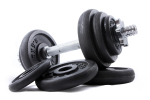- FreeTrainers.com Forums
- General Fitness & Exercise
- Progressive or not to progressive
Group: General Fitness & Exercise
Created: 2011/12/31,
Members: 383,
Messages: 54581
Various general exercise related discussions. Find out what it takes to reach your fitness goals through daily effective exercise. With so many options we try to find out what works best.
Join group
Progressive or not to progressive

maab
Posts:
35
Joined: 2002/04/29  |
2002/12/02, 02:49 PM
Greetings,I have a goal of increasing the size of my muscles somewhat and I’m following the instructions of the freetrainers.com programs. In those programs most of the exercises have four sets of downscaling repetitions, in conjunction with increasing weight, ranging from 20 or 16 to 10 or 8. What would be the difference in result between a lifting sequence of 12-10-8-6 reps and a 8-8-8-8 reps in terms of muscle mass increase? Thank you |
|
| |

rkahl
Posts:
84
Joined: 2002/11/21  |
2002/12/02, 05:42 PM
Coming down in reps or pyramid downward allows you to use heavier weights and really recruits the muscle fibers to get an adaptive response to the stress. That adaptive response is what we want. More muscle tissue. There are volume training methods where you would use the same weight for as many as 10 sets and that also has it's place. I believe the idea here is to use a weight that is very challenging at each rep range to get the results you are wanting. I am doing the same program myself and am on my second week. I find I have to focus and make the most of each set because I am used to doing more than it is suggesting. Just try to lift heavy on the short sets.-------------- Randy *Excuses are the skin of a reason stuffed with a lie.* |

mikencharleston
Posts:
1,585
Joined: 2002/01/09  |
2002/12/03, 07:58 AM
"What would be the difference in result between a lifting sequence of 12-10-8-6 reps and a 8-8-8-8 reps in terms of muscle mass increase?" I wish I had copied a previous post from bb1fit since it fits here also. Keep it simple Randy, most of the goal behind this rep scheme is to overload the muscle. What you're asking would probably result in some minimal gains for a minimum of time. If you're using the same number of reps on 4 sets but still increasing weight on the 4th set, your first 3 sets weren't anywhere near your max workout weight. The decreasing reps allow you to get a max overload but still hit enough reps to tax the muscle. I see people doing 4-6 sets of an exercise everyday and they aren't working any harder on rep 12 set 6 than they are on rep 3, set 1. |

mandre
Posts:
212
Joined: 2002/04/23  |
2002/12/03, 05:39 PM
Hey maab,When you work in 4 sets of 8 you are only recruiting one type of muscle fiber. You have Type I, Type II and Type IIB muscle fibers. In combination with your fast twitch and slow twitch. Changing the number of reps will recruit these fibers. All will give you hypertrophy. If you need futher explanation I am sure others will be able to help out. If you need more I will be back on this weekend. :) Melissa -------------- Excellence is an art won by training and habituation. We do not act rightly because we have virtue or excellence, but rather we have those because we have acted rightly. We are what we repeatedly do. Excellence, then, is not an act but a habit. - -- Aristotle |

maab
Posts:
35
Joined: 2002/04/29  |
2002/12/03, 06:30 PM
Any information you might have for this thread is very welcome to me.It was the health club’s manager that suggested me to convert my work out to the non-decreasing reps type: 10-10-10-10 or 8-8-8-8 or whatever. She thinks that in that way the muscles, with the appropriate weights, have the advance that will work hard all four times. Thank you your posts. |

rkahl
Posts:
84
Joined: 2002/11/21  |
2002/12/03, 06:34 PM
You must have misunderstood me and what I was saying. I am following the ft recommendation and doing pyramid down sets just like they suggest. I was just speaking of volume training method as opposed to pyramid method. I was not suggesting he do it but follow the ft chart and lift heavy according to the number of reps they are suggesting. You can increase the weights as the reps go down in number per set. If you can leg press 180 for 20 reps you can press 360 for 4 or 6 reps. ============ Quoting from mikencharleston: "What would be the difference in result between a lifting sequence of 12-10-8-6 reps and a 8-8-8-8 reps in terms of muscle mass increase?" I wish I had copied a previous post from bb1fit since it fits here also. Keep it simple Randy, most of the goal behind this rep scheme is to overload the muscle. What you're asking would probably result in some minimal gains for a minimum of time. If you're using the same number of reps on 4 sets but still increasing weight on the 4th set, your first 3 sets weren't anywhere near your max workout weight. The decreasing reps allow you to get a max overload but still hit enough reps to tax the muscle. I see people doing 4-6 sets of an exercise everyday and they aren't working any harder on rep 12 set 6 than they are on rep 3, set 1. ============= |

mackfactor
Posts:
766
Joined: 2002/10/17  |
2002/12/04, 02:51 PM
Actually, it is your slow-twitch, Type I fibers that are most active in hypertrophy. Generally these are activated by musclar FATIGUE. Your type II, fast twitch fibers have less potential for growth, but control your maximal strength. Type II fibers are activated by OVERLOAD. Those two concepts are very different. If you're looking to activate your Type II's, a workout of six sets of two reps would be far more effective than three sets of ten. When your Type II fibers have been worn down, your Type I's kick in and take over.Read this by Charles Staley: I’m about to challenge one of your most deeply-held beliefs about training with weights. The paradigm in question is so widely accepted that for most it is considered a simple fact of life. You might not even realize that you’re a believer, but it’s highly likely that you are. As a way of presenting my argument, let me first draw a few parallels between two hypothetical training scenarios— the first is highly unlikely, the second is ubiquitous and all-too familiar. Both, however, are equally absurd. Scenario One You’re trying to get in a decent serratus & scalene workout, but you’re finding yourself increasingly annoyed by a body pump class in the aerobics room on the other side of the glass wall. Over the course of an hour, the participants are looking sloppier and sloppier as they try to keep up with the obscenely estrogenic soundtrack (which you’ve been trying to ignore for fear of developing breast tissue). “What’s the point?” you wonder, watching the class going from crisp to wilted over the course of the sweat-fest. “They’ll never grow any muscle doing that sloppercize class!” Scenario Two The next week, you’re back in the gym performing a set of squats to failure. You reason to yourself that only an all-out assault on the bar will result in progress— no pain, no gain as they say. So you unrack the bar, step back to clear the rack, and go to war. The first 4 or 5 reps are pretty solid, but after that, you begin to slow down. Nevertheless, you manage to complete 12 reps. This is a personal record for you, but no need for congratulation: rep by rep, your fatigue levels escalate. And the more you fatigue, the less force you exert on the bar. The less force you exert, the less your training targets the fast twitch fibers and the more it targets the slow twitch fibers. Oh, by the way— fast twitch fibers are so-named because they make you fast, while slow twitch fiber development slows you down. Now, what did you say your reason for strength training was??!! OK, look— if you’re feeling somewhat discouraged by the sudden realization that all the weight training you’ve done (for who knows how many years) is ineffective, take heart— you’re not alone! Based on my experiences consulting with athletes for the past 20 years, I’d estimate that well over 99% of those who train with weights subscribe to the erroneous notion that the primary goal of training is to achieve a high level of fatigue. If you’re looking for membership in the 1% club, it’s time for a paradigm shift. Here it is: The effectiveness of training is not determined by the amount of fatigue it produces; but rather, by the degree to which it improves the skill or quality which is being trained. In strength training (as in most other pursuits), the “quality” of a training session is defined and measured by how closely it approximates your maximum capabilities. Careful! You’ll Poke Your Eye Out With That Thing! To read the rest, go here: http://www.bodybuilding.com/fun/staley2.htm -------------- "Don't follow leaders and watch your parking meters!" -- Bob Dylan |

mandre
Posts:
212
Joined: 2002/04/23  |
2002/12/06, 05:41 PM
There are many different ways to train. Never ever limit yourself to one way. There is more but this is the gist of it,I hope this comes out ok. If not copy it and put it into excel. Overview Muscle Fibers Type Slow Twitch (I) Fast Twitch ( IIA) Fast Twitch (IIB) Power of Contraction Low High High Fatigue Resistance High Medium Low Oxidative Capacity High High Low Anaerobic Enzyme Content Low Medium High Mitochondria Several Several Few Capillaries Several Several Few Myoglobin Content High High Low Color of Fiber Red Red White Glycogen Content Low Medium High Myoglobin Content High High Low Fiber Diameter Small Medium Large Thirdly, studies have shown that athletes can cause muscle fibers to act more like there counter parts. In other words, you can make a slow twitch muscle fiber act more like a fast twitch fiber. Which means that it will be able to twitch faster. ( this also works opposite, for example, most bodybuilders fast twitch IIB fibers behave like fast twitch IIA fibers. This is a good thing and will be discussed in a bit. ). If a muscle can twitch faster it can produce more force. ( 12, 13, 14, ) As you can see, strength gain in the 1-5 repetition range can take place without muscular hypertrophy. Does this mean that growth cannot occur at these junctions? Certainly not, it simply means that growth can take place, but it is certainly not the optimal method of adaptation in this zone. The reason for this is twofold. Firstly lower rep sets do not recruit as many muscle fibers as higher repetition sets. Grant it, they do recruit more motor units at once, but due to signaling problems occurring in the nervous system they cannot recruit nearly as many, as compared to a longer set. You see the nervous system is asked to act extremely fast and furiously under this circumstance, and it is taxed to its limit. Secondly, the contractile proteins in a cell are responsible for most muscular growth. These must be exposed to enough stress or they will not be damaged enough to overcompensate by increasing in size. Therefore it is not enough to recruit a muscle fiber, you must also damage the actin and myosin filaments if it is to grow. In regards to bodybuilding, I personally never recommend lifting in the 1-2 repetition range. However, used correctly 3-5 repetition sets can stimulate hypertrophy in your fast twitch IIB fibers. If you are experiencing a plateau in growth, I would suggest starting your routine out with a few sets in this range. It will not work very long as far as mass gains are concerned, but in this sport we should take advantages of every opportunity to grow. This style of training is also of extreme benefit( beside its obvious benefit to strength athletes ) to someone who must maintain his weight and gain strength. For example, wrestlers, boxers, martial artists, track stars etc. It can also be applied to other activities that cause an athlete to recruit as many motor units as possible in a short amount of time. Plyometrics( 18 ) have become quite popular for such specific reasons and they take full advantage of elastic energy specifically. This can enhance your ability to start, jump and explode out of the hole. Overview Growth In Muscle Fibers Below Repetition Range Type I Type IIA Type IIB Strength Gains 1-2 repetitions Very Low Low Low Excellent 3-5 repetitions Very Low Low Decent to Good Excellent 6-8 repetitions Very Low Good Excellent Good 9-12 repetitions Low Excellent Very Good Good Within Rep R. 13-15 repetitions Decent Very Good Decent to Good Endurance 16-25 repetitions Very Good Diminishing Low Endurance 25-50 repetitions Excellent Low Very Low Endurance 7. Slow Twitch Muscle Fibers - The story on working type I cells begins happily, but has a sad ending. The reason why it begins so easily is due to their low thresholds. Which is to say, any low weight exercise immediately recruits slow twitch motor units! If you can recruit them, you can stimulate growth in them! So far so good. The sad ending however is the extreme pain you will have to endure to actually force them to hypertrophy! Believe me, benching 135 pounds might seem like easy money, but lifting it for 100 reps is about as hardcore as a human being can get! The throbbing pain is almost too much to bare! Never the less, that is what it takes. Fail or come close to failure in the repetition range that I discussed above and your slow twitch muscle fibers will give you more mass then you would have believed! courtesy of Jacob Wilson Trainer@Abcbodybuilding.com References 1. Lim, Daniel. 1998. Microbiology, 2nd edition. William C. Brown/McGraw Hill. New York. 2. Kornberg, Arthur. 1989. For the love of enzymes. Harvard University Press. Cambridge, MA 3. D.L. Costill et. al., The Role of dietary carbohydrates in muscle glycogen re-synthesis. American Journal of Clinical Nutrition 34, 1981 4.Dudley GA (1988) Metabolic consequences of resistive-type exercise. Med Sci Sports Exerc. 20(5 Suppl):S158-S161 5. Brooke & Kaiser, 1970 6. Cedrick, (1995). Strength and Conditioning Journal 17 7. BENEDICT, TAN, 1999: Manipulating Resistance Training Program Variables to Optimize Maximum Strength in Men: A Review. The Journal of Strength and Conditioning Research: Vol. 13, No. 3, pp. 289–304. 8. HARRIS, GLENN R., MICHAEL H. STONE, HAROLD S. O'BRYANT, CHRISTOPHER M. PROULX, ROBERT L. JOHNSON, 2000: Short-Term Performance Effects of High Power, High Force, or Combined Weight-Training Methods. The Journal of Strength and Conditioning Research: Vol. 14, No. 1, pp. 14–20 9. Hoeger, Werner W.K., Sandra L. Barette, Douglas F. Hale, David R. Hopkins, 1987: Relationship Between Repetitions and Selected Percentages of One Repetition Maximum. The Journal of Strength and Conditioning Research: Vol. 1, No. 1, pp. 11–13 10. Ruther, Christine L., Catherine L. Golden, Robert T. Harris, Gary A. Dudley, 1995: Hypertrophy, Resistance Training, and the Nature of Skeletal Muscle Activation. The Journal of Strength and Conditioning Research: Vol. 9, No. 3, pp. 155–159 11. Fukui, Y. et al. (1986). High-resolution immunofluorescence for the study of the contractile apparatus. In "The Contractile Apparatus and the Ctyoskeleton" ("Structure and Contractile Proteins", Meth.Enzymol.134, Part D), ed R. B. Vallee, Academic Press, pp. 573-580. 12. Henneman, E et al "Functional Significance of cell size in spinal motor neurons." Journal of Neurophysiology 28: 560-580. 1965. 13. Komi, P.V. "Training of muscle strength and power: interaction of neuromotoric, hypertrophic, and mechanical factors." International Journal of Sports Medicine 7: 10-15. 1986. 14. Barnett, C. et al "Effects of Variations of the bench press exercise on the EMG activity of five shoulder muscles." Journal of Strength and Conditioning Research 9(4): 222-227. 1995. 15. ('Effects of Exercise on Mitochondrial Oxygen Uptake and Respiratory Enzyme Activity in Skeletal Muscle,' The Journal of Biological Chemistry, vol. 242(9), pp. 2278-2282, 1967). 16. 'Influence of Exercise Intensity and Duration on Biochemical Adaptations in Skeletal Muscle,' Journal of Applied Physiology, vol. 53(4), pp. 844-850, 1982). 17. Hedrick, Allen, 1995: Training for Hypertrophy. Strength and Conditioning: Vol. 17, No. 3, pp. 22–29. 18. Polhemus, Russ, Dr. Ed Burkhardt, 1980: THE EFFECTS OF PLYOMETRIC TRAINING DRILLS ON THE PHYSICAL STRENGTH GAINS OF COLLEGIATE FOOTBALL PLAYERS. National Strength Coaches Association Journal: Vol. 2, No. 5, pp. 14–17. 19. Berg, Kris, 1982: Exercise Physiology Corner: Anaerobic Conditioning: Training the Three Energy Systems. National Strength Coaches Association Journal: Vol. 4, No. 1, pp. 48–50. 20. Craig, Bruce W., 2001: BRIDGING THE GAP: Explosive Training and Muscle Calcium Usage. Strength and Conditioning Journal: Vol. 23, No. 6, pp. 47–48. 21. Pauletto, Bruno, 1985: Let's Talk Training #1: Sets and repetitions. National Strength & Conditioning Association Journal: Vol. 7, No. 6, pp. 67–69. 22. Banister, E. W., 1979: RESEARCH REPORT: Strength Gains From Muscle Training: Preparation For Competition. National Strength Coaches Association Journal: Vol. 1, No. 6, pp. 24–29. 23. Stone, Michael H., Dennis Wilson, Ralph Rozenek, Harvey Newton, 1983: Bridging the Gap: Anaerobic Capacity. National Strength & Conditioning Association Journal: Vol. 5, No. 6, pp. 40–40. www.abcbodybuilding.com May issue muscle fibers :) Melissa P.S. You will never know what new heights you can reach without the standards. Diet, sleep, training and hydration. -------------- Excellence is an art won by training and habituation. We do not act rightly because we have virtue or excellence, but rather we have those because we have acted rightly. We are what we repeatedly do. Excellence, then, is not an act but a habit. - -- Aristotle |

rkahl
Posts:
84
Joined: 2002/11/21  |
2002/12/06, 05:54 PM
Good post. |
